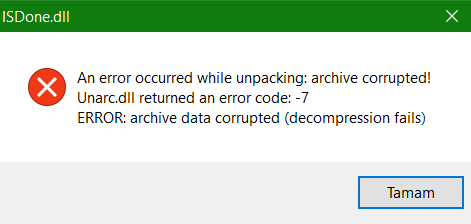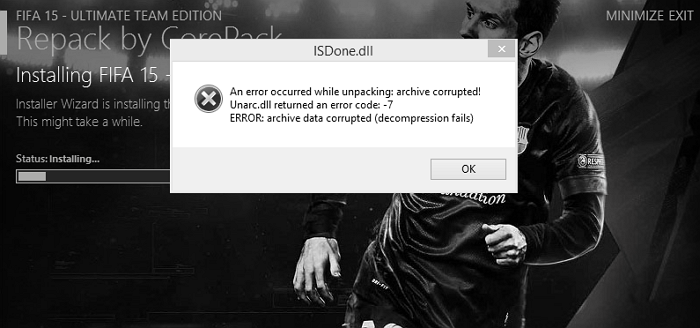The isDone.dll error message sometimes seen in Windows 11 and Windows 10 is related to the incomplete installation of PC games or files of larger size. As we know, games with good graphics and fast play are resource-intensive and consume much storage space. As such, they must be compressed before downloading to your PC and then unpacked to the hard drive before installation. If any error occurs in your PC’s RAM during this process or the Hard Disk doesn’t have sufficient memory to handle the process, your PC may flash the ISDone.dll error with the following message,
An error occurred when unpacking, Unarc.dll returned error code -1, ERROR: archive data corrupted (decompression fails).

The error code may vary, but the only button you can see is – OK.
The ISDone.dll error appears due to a faulty Unarc.dll file residing in the System32 folder on 32-bit operating systems and the SysWOW64 folder on 64-bit systems. So, if you see this error message, it means your computer could not read installation archive files.
What is the Unarc.dll file?
Unarc.dll is a dynamic link library for Windows. Some applications or games require this file to function correctly. So, if it goes missing or an error occurs when you start a game or an application, you may get various kinds of errors.

ISDone.dll error while playing games on PC
Follow these steps to resolve this DLL error
- Reinstall the Game
- Reregister the .dll file using regsvr32 tool
- Troubleshoot in the clean boot state
- Update Graphics Drivers
You will need an administrator account to resolve this.
1] Reinstall the Game
isDone.dll error sometimes also appears due to the installation of an unknown application or if the application has become outdated or corrupted.
If the game downloaded is corrupted or broken, the error message can be fixed by simply reinstalling the game. So, install the latest updated new copy of the game and check if the problem is fixed.
2] Reregister the .dll file using regsvr32 tool
First, locate the current Unarc.dll file on your computer and rename it to – Unarc-bak.dll.
Now take a good copy of Unarc.dll from another computer and temporarily save it to the Desktop.
Now move this new DLL file to:
- System32 folder on 32-bit operating systems
- SysWOW64 folder on 64-bit systems.
Now you need to register the new DLL file, Open an elevated PowerShell window and execute the following command:
regsvr32 %systemroot%\System32\unarc.dll
If it is placed in SysWOW64, then the command would be:
regsvr32 %systemroot%\SysWOW64\unarc.dll
When done, you’ll see a message indicating the .dll file was registered.
3] Troubleshoot in the clean boot state
Performing a Clean Boot state helps in identifying if any third-party applications or startup items are causing conflicts.
So, boot your PC in Clean Boot State and try to isolate the issue manually. To perform clean-boot troubleshooting, you must take several actions and then restart the computer after each action. You may need to manually disable one item after another to pinpoint the one causing the problem. Once you have identified the offender, you can consider removing or disabling it.
4] Update Graphics Drivers
You may also update your Graphics drivers via Devices Manager and see if that helps.
I hope something here has helped you.
What causes DLL errors?
There can be multiple reasons why Windows causes DLL errors, but one of the most common is when the DLL goes missing or gets corrupt. DLL or Dynamic Linked Library is an essential part of the System files, and sometimes it is shared as well. So if a DLL goes bad, then chances are that more than one thing will fail.
Where are DLL files stored in Windows?
Most of the DLL files are available at C:\Windows\System32. However, depending on the program, it can be available somewhere else, which is usually the case when an application doesn’t share the DLL with any other program.
How to register a DLL File?
If you are placing a healthy copy of a DLL file and want to re-register to ensure it is available with the OS, you need to use the regsvr32 followed by the exact path of the DLL file. Make sure to execute it on an elevated Command Prompt or Windows Terminal.